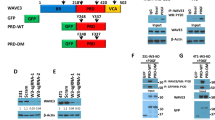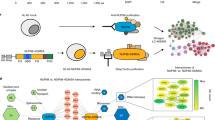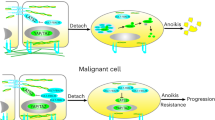Abstract
CRKI (SH2-SH3) and CRKII (SH2-SH3-SH3) are splicing isoforms of the oncoprotein CRK that regulate transcription and cytoskeletal reorganization for cell growth and motility by linking tyrosine kinases to small G proteins. CRKI shows substantial transforming activity, whereas the activity of CRKII is low, and phosphorylated CRKII has no biological activity whatsoever. The molecular mechanisms underlying the distinct biological activities of the CRK proteins remain elusive. We determined the solution structures of CRKI, CRKII and phosphorylated CRKII by NMR and identified the molecular mechanism that gives rise to their activities. Results from mutational analysis using rodent 3Y1 fibroblasts were consistent with those from the structural studies. Together, these data suggest that the linker region modulates the binding of CRKII to its targets, thus regulating cell growth and motility.
This is a preview of subscription content, access via your institution
Access options
Subscribe to this journal
Receive 12 print issues and online access
$189.00 per year
only $15.75 per issue
Buy this article
- Purchase on Springer Link
- Instant access to full article PDF
Prices may be subject to local taxes which are calculated during checkout





Similar content being viewed by others
References
Cheresh, D.A., Leng, J. & Klemke, R.L. Regulation of cell contraction and membrane ruffling by distinct signals in migratory cells. J. Cell Biol. 146, 1107–1116 (1999).
Tanaka, S., Ouchi, T. & Hanafusa, H. Downstream of Crk: activation of JNK by v-Crk through the guanine nucleotide exchange protein C3G. Proc. Natl. Acad. Sci. USA 94, 2356–2361 (1997).
Tanaka, S. et al. Both the SH2 and SH3 domains of human Crk protein are required for neuronal differentiation of PC12 cells. Mol. Cell. Biol. 13, 4409–4415 (1993).
Kiyokawa, E. et al. Activation of Rac1 by a Crk SH3-binding protein, DOCK180. Genes Dev. 12, 3331–3336 (1998).
Oktay, M., Wary, K.K., Dans, M., Birge, R.B. & Giancotti, F.G. Integrin-mediated activation of focal adhesion kinase is required for signaling to Jun NH2-terminal kinase and progression through the G1 phase of the cell cycle. J. Cell Biol. 145, 1461–1469 (1999).
Feller, S.M. Crk family adaptors — signalling complex formation and biological roles. Oncogene 20, 6348–6371 (2001).
Linghu, H. et al. Involvement of adaptor protein Crk in malignant feature of human ovarian cancer cell line MCAS. Oncogene 25, 3547–3556 (2006).
Nishihara, H. et al. Molecular and immunohistochemical analysis of adaptor protein Crk in human cancers. Cancer Lett. 180, 55–61 (2002).
Beer, D.G. et al. Gene-expression profiles predict survival of patients with lung adenocarcinoma. Nat. Med. 8, 816–824 (2002).
Miller, C.T. et al. Increased C-Crk proto-oncogene expression is associated with an aggressive phenotype in lung adenocarcinomas. Oncogene 22, 7950–7957 (2003).
Takino, T. et al. CrkI adapter protein modulates cell migration and invasion in glioblastoma. Cancer Res. 63, 2335–2337 (2003).
Konishi, H. et al. Detailed characterization of a homozygously deleted region corresponding to a candidate tumor suppressor locus at distal 17p13.3 in human lung cancer. Oncogene 22, 1892–1905 (2003).
Watanabe, T. et al. Adaptor molecule Crk is required for sustained phosphorylation of Grb2-associated binder 1 and hepatocyte growth factor-induced cell motility of human synovial sarcoma cell lines. Mol. Cancer Res. 4, 499–510 (2006).
Matsuda, M. et al. Two species of human Crk cDNA encode proteins with distinct biological activities. Mol. Cell. Biol. 12, 3482–3489 (1992).
Feller, S.M., Knudsen, B. & Hanafusa, H. c-Abl kinase regulates the protein binding activity of c-Crk. EMBO J. 13, 2341–2351 (1994).
Rosen, M.K. et al. Direct demonstration of an intramolecular SH2-phosphotyrosine interaction in the Crk protein. Nature 374, 477–479 (1995).
Guinier, A. & Fournet, G. Small-Angle Scattering of X-ray (John Wiley & Sons, New York, 1955).
Kurokawa, K. et al. A pair of fluorescent resonance energy transfer-based probes for tyrosine phosphorylation of the CrkII adaptor protein in vivo. J. Biol. Chem. 276, 31305–31310 (2001).
Cotton, G.J. & Muir, T.W. Generation of a dual-labeled fluorescence biosensor for Crk-II phosphorylation using solid-phase expressed protein ligation. Chem. Biol. 7, 253–261 (2000).
Yuzawa, S. et al. Solution structure of Grb2 reveals extensive flexibility necessary for target recognition. J. Mol. Biol. 306, 527–537 (2001).
Donaldson, L.W., Gish, G., Pawson, T., Kay, L.E. & Forman-Kay, J.D. Structure of a regulatory complex involving the Abl SH3 domain, the Crk SH2 domain, and a Crk-derived phosphopeptide. Proc. Natl. Acad. Sci. USA 99, 14053–14058 (2002).
Guntert, P. Automated NMR structure calculation with CYANA. Methods Mol. Biol. 278, 353–378 (2004).
Brunger, A.T. et al. Crystallography & NMR system: a new software suite for macromolecular structure determination. Acta Crystallogr. D Biol. Crystallogr. 54, 905–921 (1998).
Anafi, M., Rosen, M.K., Gish, G.D., Kay, L.E. & Pawson, T. A potential SH3 domain-binding site in the Crk SH2 domain. J. Biol. Chem. 271, 21365–21374 (1996).
Wu, X. et al. Structural basis for the specific interaction of lysine-containing proline-rich peptides with the N-terminal SH3 domain of c-Crk. Structure 3, 215–226 (1995).
Shishido, T. et al. Crk family adaptor proteins trans-activate c-Abl kinase. Genes Cells 6, 431–440 (2001).
Ogawa, S. et al. The C-terminal SH3 domain of the mouse c-Crk protein negatively regulates tyrosine-phosphorylation of Crk associated p130 in rat 3Y1 cells. Oncogene 9, 1669–1678 (1994).
Akakura, S. et al. C-terminal SH3 domain of CrkII regulates the assembly and function of the DOCK180/ELMO Rac-GEF. J. Cell. Physiol. 204, 344–351 (2005).
Zvara, A. et al. Activation of the focal adhesion kinase signaling pathway by structural alterations in the carboxyl-terminal region of c-Crk II. Oncogene 20, 951–961 (2001).
Muralidharan, V. et al. Solution structure and folding characteristics of the C-terminal SH3 domain of c-Crk-II. Biochemistry 45, 8874–8884 (2006).
Sabe, H., Okada, M., Nakagawa, H. & Hanafusa, H. Activation of c-Src in cells bearing v-Crk and its suppression by Csk. Mol. Cell. Biol. 12, 4706–4713 (1992).
Sarkar, P., Reichman, C., Saleh, T., Birge, R.B. & Kalodimos, C.G. Proline cis-trans isomerization controls autoinhibition of a signaling protein. Mol. Cell 25, 413–426 (2007).
Cavanagh, J., Fairbrother, W.J., Palmer, A.G., III & Skelton,, N.J. Protein NMR Spectroscopy: Principles and Practice (Academic Press, San Diego, 1996).
Bartels, C., Xia, T.-H., Billeter, M., Güntert, P. & Wüthrich, K. The program XEASY for computer-supported NMR spectral analysis of biological macromolecules. J. Biomol. NMR 6, 1–10 (1995).
Cornilescu, G., Delaglio, F. & Bax, A. Protein backbone angle restraints from searching a database for chemical shift and sequence homology. J. Biomol. NMR 13, 289–302 (1999).
Yuzawa, S. et al. Solution structure of the tandem Src homology 3 domains of p47phox in an autoinhibited form. J. Biol. Chem. 279, 29752–29760 (2004).
Akagi, T., Sasai, K. & Hanafusa, H. Refractory nature of normal human diploid fibroblasts with respect to oncogene-mediated transformation. Proc. Natl. Acad. Sci. USA, 100, 13567–13572 (2003).
Acknowledgements
We thank M. Tsuda (Hokkaido University) for preparation of time-lapse images, and H. Hanafusa and T. Iwahara (Osaka Bioscience Institute) for valuable suggestions on this work. D. Baltimore (California Institute of Technology) developed BOSC23 packing cells used in the protein-expression system. This work was supported by Grants-in-Aid for Scientific Research and the National Project on Protein Structural and Functional Analyses from the Ministry of Education, Science and Culture of Japan. Y.K. is a research fellow of the Japan Society for the Promotion of Science.
Author information
Authors and Affiliations
Contributions
Y.K. performed the structural studies, analyzed data and prepared the manuscript. M.S. performed the cellular experiments and data analysis. M.N. prepared phosphorylated CRKII for NMR measurements. M.Y., H.K. and K.O. assisted with the NMR experiments and analysis. Y.M. performed binding assays and assisted with cellular analysis. S.T. supervised the biological assays and prepared the manuscript. F.I. supervised all work and prepared the manuscript.
Corresponding authors
Ethics declarations
Competing interests
The authors declare no competing financial interests.
Supplementary information
Supplementary Fig. 1
Chemical shift difference between full-length pCRKII, pCRKII1–228 and isolated cSH3210–304. (PDF 190 kb)
Supplementary Fig. 2
Overlay of the 1H-15N HSQC spectra of wild-type CRKII and ISC mutants. (PDF 1635 kb)
Supplementary Fig. 3
Steady state NOE of CRKII in free and bound state of SOS-derived VPP peptide. (PDF 112 kb)
Supplementary Fig. 4
Overlay of the 1H-15N HSQC spectra of wild-type CRKII and CRKII(W275K). (PDF 867 kb)
Supplementary Video 1
Time–lapse microscopical analysis of the wound-healing assay of CRKI-expressing cells. (MOV 2889 kb)
Supplementary Video 2
Time–lapse microscopical analysis of the wound-healing assay of CRKII-expressing cells. (MOV 3201 kb)
Supplementary Video 3
Time–lapse microscopical analysis of the wound-healing assay of CRKII(Δ226–237)-expressing cells. (MOV 2997 kb)
Supplementary Video 4
Time-lapse microscopic analysis of the wound-healing assay of CRKII(m226–237)-expressing cells. (MOV 2417 kb)
Supplementary Video 5
Time-lapse microscopic analysis of the wound-healing assay of mock cells. (MOV 2457 kb)
Rights and permissions
About this article
Cite this article
Kobashigawa, Y., Sakai, M., Naito, M. et al. Structural basis for the transforming activity of human cancer-related signaling adaptor protein CRK. Nat Struct Mol Biol 14, 503–510 (2007). https://doi.org/10.1038/nsmb1241
Received:
Accepted:
Published:
Issue Date:
DOI: https://doi.org/10.1038/nsmb1241
This article is cited by
-
MicroRNA expression profile in bovine mammary gland parenchyma infected by coagulase-positive or coagulase-negative staphylococci
Veterinary Research (2021)
-
Atomic view of the energy landscape in the allosteric regulation of Abl kinase
Nature Structural & Molecular Biology (2017)
-
A novel molecular dynamics approach to evaluate the effect of phosphorylation on multimeric protein interface: the αB-Crystallin case study
BMC Bioinformatics (2016)
-
A lack of peptide binding and decreased thermostability suggests that the CASKIN2 scaffolding protein SH3 domain may be vestigial
BMC Structural Biology (2016)
-
A pre-metazoan origin of the CRK gene family and co-opted signaling network
Scientific Reports (2016)



